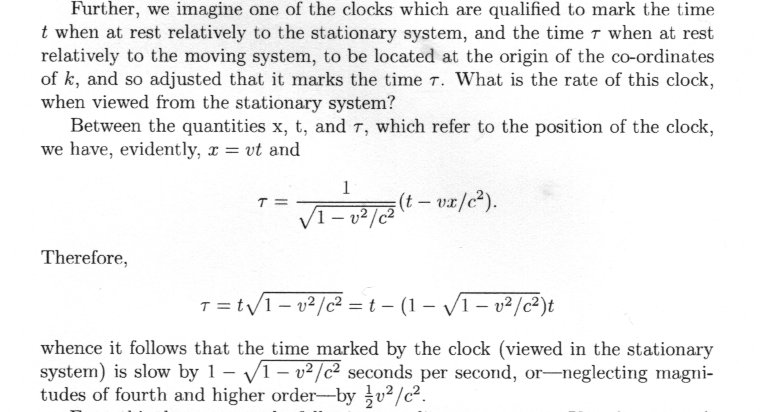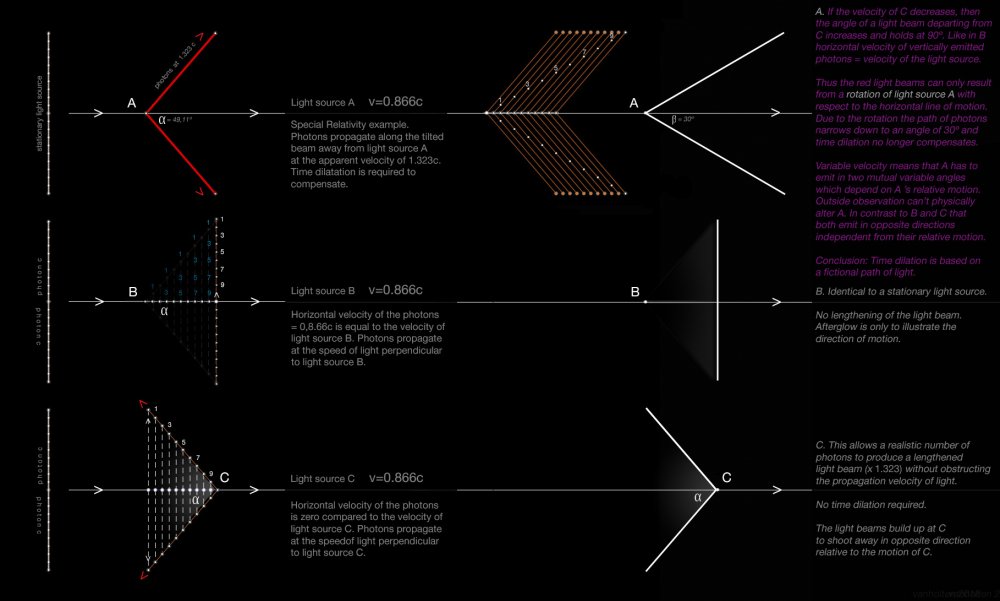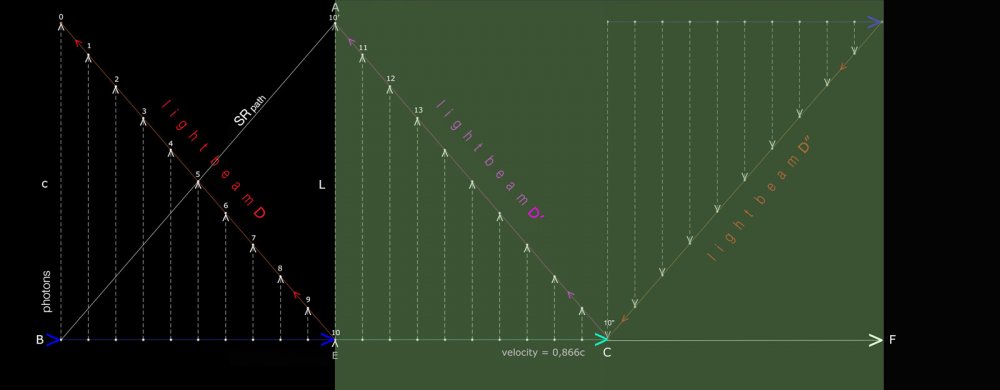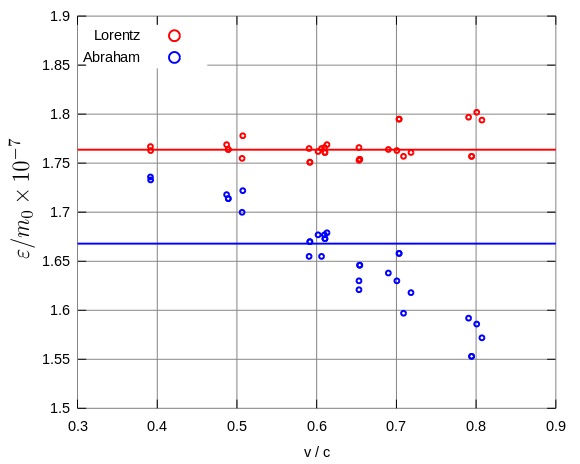-
Posts
67 -
Joined
-
Last visited
Content Type
Profiles
Forums
Events
Posts posted by vanholten
-
-
On 09/11/2018 at 2:06 AM, Conjurer said:

Interesting is that Einstein wrote: “What is the rate of the clock, when viewed from the stationary system?”
The formula that follows does not show a parameter for the “rate” of the clock (or frequency regarding the light clock). Suppose two observers, stationary compared to their own light clocks, are in relative motion. They uniformly move parallel away from each other over an agreed fixed distance. At the end of the trajectory both observers will have counted an equal number of reflector hits for both clocks, the moving clock and the stationary clock. This outcome is supported by the formula for time dilation. The presumed relativistic lengthening of the path of a photon has no effect on the rate of the photon hitting the reflectors. Because if that were the case the factor 2L would not apply and the formula would fall short.
Since the frequency of both stationary and moving light clocks is identical to both observers in relative motion, I am afraid time dilation is pointless.
0 -
On 31-10-2018 at 11:03 AM, swansont said:
The motion of the light source has no effect after the photon is emitted, so if the the light source changes its motion, it will not affect a photon that has already been emitted.
If you have a light source shining on a target (y direction), and you and that system are in relative motion (x direction), the light will still hit the target. From your reference frame, the laser + target system is moving, and the photon is emitted at an angle that is not perpendicular to its motion.
(light has momentum, BTW)
9 hours ago, swansont said:Then it's meaningless and confusing. I don't know what your diagram is supposed to be showing.
No, that's not what time dilation's formula does. The light clock formulation looks at the path of a single photon. Any analysis that looks at multiple photons is not valid, as the photons' behavior need not be correlated — they are independent from each other.
Thanks for analyzing this so precisely. It might be confusing, but it's not meaningless. The diagram pictures all possibilities of the relation light/ light source we discussed in this topic. I created this diagram to help understand what the problem actually is. In a first attempt I misinterpret diagram B myself and had to insert numbers to identify the path of the individual photons and get a clear picture.
Option A corresponds with the common explanation. You can choose the path of each single photon displayed on the diagram. This won't alter the fact that emission under the angle of 49,11º geometrically results in the photon moving at an angle of 30º to the horizontal. The photon won't hit the mirror. This is only one of the objections against emission at an angle. More problematic is the fact that this altered angle has to have a physical cause. The adjustment of the reflectors can't be achieved by relative observation.
Option B. This is option is based on a perception similar to your first quote:
"If you have a light source shining on a target (y direction), and you and that system are in relative motion (x direction), the light will still hit the target."
In option B, indeed the light will hit the target despite of it being in relative horizontal motion. If the photons move along with their light source they produce these straight vertical beams that will fit the clock. This is what I tried to illustrated with the ruler.
You replied as quoted above: "The light clock formulation looks at the path of a single photon.- Any analysis that looks at multiple photons is not valid, as the photons' behavior need not be correlated — they are independent from each other."
Diagram B gives the possibility to connect the positions of a single photon over a timespan. Equipped with a mirror the experiment would show a single photon zigzagging up and down; an image similar to most popular illustrations of time dilation.
However, there is a major problem to this. Diagram B shows the actual path of the sequence of photons emitted as 1,2,3,4,5 etc. This actual sequence is perpendicular to the horizontal motion of the light source C. The actual velocity of these photons is c. Connecting all positions of photon 1 results in a straight line 49,11º rotated away from the horizontal measuring 1.323C. Connecting all positions of photon 2 results in a straight line paralel to this first line. Doing the same to photon 3 gives a total of three parallel straight lines and so on. Eventually you create a field of paralel straight lines.
The exact shape of this field is a priori imposed by the horizontal distance in which the light source travels at 0.866c compared to the vertical distance of photons traveling at c. Both distances are expressed in the speed of light. In other words: The dimensions and the proportional relations within this field are supervised by the propagation velocity of light in vacuum.
Suppose SR claims that this field produces a path of photons that deviates from the speed of light, since the length is 1.323. To correct this path and to match it with the speed of light, time dilation needs to be applied. Then the following would happen. If you correct any proportional relation within this field from which all dimensions are imposed by photons traveling at the speed of light, it is inevitable that you retrospectively correct the initial velocity of all these photons and thus the propagation velocity of light in vacuum. Time dilation in B would be like adjusting a diagonal of a square by giving it the length of one side. Because it's obvious light coming from C will never hit the clock's reflector, I think we ran out of possibilities.
0 -
1 hour ago, swansont said:
"If the velocity of C decreases"
This is about uniform motions and has nothing to do with acceleration. I didn't introduce a parameter for acceleration. It must be my failing translation. If I would have written: " At lower velocities", or "v< 0,866c" which does't change anything to the geometry, then will you accept that I did not introduce acceleration?
0 -
32 minutes ago, swansont said:
"If the velocity of C decreases"
Changing velocity is an acceleration
Which means they travel a diagonal path for the other observer, but still move at c. And that requires length contraction and time dilation.
I showed you in B the line consisting of 1’s measuring 1.323c is not the path of light. The light beam is build up from the source.
Exactly like you move the top of a vertical ruler along a horizontal line and push it upwards to increase the length above the horizontal. You can’t say that the path of the ruler corresponds with a line connecting the top positions, nor that the length of the ruler is stretched. However, that is what time dilation’s formula does.
0 -
58 minutes ago, swansont said:
Acceleration is a new twist you've added. It's usually best to get the basics down before adding complications.
If the source and target are moving, and the light were emitted perpendicular to the source, the light would miss the target. We do not observe this happening. Thus, any conclusion drawn from this idea is wrong.
I did not add acceleration. Please take another look. Indeed the light would miss it’s target. You don’t observe this happening, because it doesn’t happen.
There is no time dilation. Your observation corresponds with B that is exactly according to your previous post, in which you stated the photons move along with the light source.
0 -
On 31-10-2018 at 5:24 PM, swansont said:
If the source and target are both moving, all of the photons hit the target. There are none traveling vertically. You need to pick one frame and describe it. Otherwise you mix up two frames, and get a nonsensical result.
Here is another image.
A. If the velocity of C decreases, then the angle of a light beam departing from C increases and holds at 90º. Like in B horizontal velocity of vertically emitted photons = velocity of the light source. Thus the red light beams can only result from a rotation of light source A with respect to the horizontal line of motion. Due to the rotation the path of photons narrows down to an angle of 30º and time dilation no longer compensates. Variable velocity means that A has to emit in two mutual variable angles which depend on A ’s relative motion. Outside observation can’t physically alter A. In contrast to B and C that both emit in opposite directions independent from their relative motion. Conclusion: Time dilation is based on a fictional path of light.
B. Identical to a stationary light source. No lengthening of the light beam. Afterglow is only to illustrate the direction of motion.
C. This allows a realistic number of photons to produce a lengthened light beam (x 1.323) without obstructing the propagation velocity of light. No time dilation required. The light beams build up at C to shoot away in opposite direction relative to the motion of C.
0 -
I think it’s very confusing that both options have the same requirement for the clock to work.
- SR needs the photons to propagate vertically aligned with the light source, to make the clock work.
- The second option also needs the photons to propagate vertically aligned with the light source, to make the clock work.
Perhaps the clock should be put aside for the moment, so it no longer matters if it works or not. Then the remaining issue is the increased length of the light beam and its direction. The length increase is the same in both options. However the directions compared to the motion are opposite.
Only SR has additional requirements. It needs time-dilatation to explain the increased length and the direction of the beam. The other option needs no further explanation since time is running as usual, and the direction of the beam is natural consequence of the motion of the light source.
0 -
The second case shows that if photons behave like that, the clock doesn’t work at all. It would only work when stationary, and all photons choose the same path upwards.
0 -
5 hours ago, swansont said:
The motion of the light source has no effect after the photon is emitted, so if the the light source changes its motion, it will not affect a photon that has already been emitted.
I agree and with you at this point and with @quiet. To picture what I thinks is realistic, I created the image below.
-The SR path corresponds with the idea of photons keeping up with the light source. The image has the same setup as the Lorentz Clock in relative constant motion 0,866c
The SR experiment suggests the light lengthens its path due to relative observation. Since it can only travel at c the path is too long and therefore time has to be adjusted. To account for the lengthening of the path, the formula for time dilation is used.
∆t'= ∆t /√(1-(v/c)²) = ∆t /√(1-(0,866)²) = ∆t /√0,25 = ∆t /0,5 = 2 ∆t
-Classic Physics. The dashed lines are the path of photons moving perpendicular to the light-source and persevering in a straight line.
At the point where photon 10 leaves the light-source, the light source traveled the distance BE. Meanwhile photon 0 already traveled the distance equal to L. For photon 10 to travel L and to reach A, the light source has to travel the distance EC. For photon 10 to bounce back and hit the light-source (the reflector) has to travel the distance CF.
This results in the same lengthening of the “light beams”. However the path of the photons themselves is not lengthened. The propagation velocity of the photons remains c as usual. Because nothing changed, there is no need to adjust time.
If this corresponds with reality time dilatation is not happening.
(You can still apply the time dilation formula as an analogy if you like, and will get the exact same outcome. I am untidy with numbers so please check this out)
0 -
Straight light beams appear not to be so obvious anymore.
The airybeam gives some better understanding of what light is capable of. Researchers say the are able to create self healing lightbeams that actually curve. The curvation of a light beam due to the absence of inertia might not be such a wierd idea. It’s difficult stuff though. I don’t pretend to fully understand it. Still trying to get a grip.
https://physics.aps.org/featured-article-pdf/10.1103/PhysRevLett.108.163901
0 -
1 hour ago, Ghideon said:
If you turn or brake the photons does not track you and obviously the apple does not track you either.
You mean if you turn or brake, the photons don't keep track of the pen?
46 minutes ago, Ghideon said:1: Why should photons miss the apple?
The photons wouldn't miss the apple because they are traveling way too fast to miss it. If the photons were traveling ultra slow (or you would be able to throw the apple high enough) why should they hit apple? ( Not just because it 's such a very big apple you can hardly miss anyway.) Contrary to the apple they have neither inertia, nor rigidity and they don't keep track of the light source either.
In other words: Why do photons adapt the constant velocity of the light source, that is perpendicular to their own propagation, when the reasons I suggested are all invalid. You all say they do, but I still miss the physical explanation.
0 -
Thanks for the relativistic explanation. But I was looking a bit closer to home. If I ride my bicycle and throw an apple straight in the air, it falls back in my hand, when not too much wind or wobbling. When I point a laser pen straight up, why should a photon at a light second away keep track of me?
0 -
I am still not sure if what you say is in line with my own thoughts on this.
When a light source in constant motion emits a first photon, it will travel away from the source at c. Assuming the light beam is not rigid, then the source and the photon loose connection. Because the light source has no means to transfer its motion retrospectively to the photon, I would say the photon perseveres in its perpendicular path independent of the motion of the light source.
If the light source would be able to transfer its motion to the photon, then the photon would seem to act as if it had inertia, which it can’t have since it has no mass. Another explanation for inertia could be that it's not mass related but energy related, and has to do with energy conservation of the light waves, resulting in some kind of rigidity. However you explained light has no rigidity to it, so that is no option.
Next a second photon is shot away and like the first, perpendicular to the motion of the light source. I would say both photons wouldn’t follow the exact same perpendicular track. And that a stream of photons traveling astronomical distances would show the light beam bending away from the light source. Indeed due to the fact the beam has neither inertia, nor rigidity. I assume that such bending not necessarily affects the propagation velocity of light, but that it might cause some frequency shifts.
The lasers of LIGO interferometers are among to the most accurate on earth. I wonder if the laser beams while maintaining c of course, show any signs of deflection caused by the motion of earth.
0 -
17 minutes ago, swansont said:
Light beams are not rigid.
If we're talking about motion at a constant velocity, then the behavior of the light is exactly the same is if it were stationary, and everything else was moving.
Do you mean that the light source being part of everything else moves away from the light that is already on its way?
0 -
Hello, just a question.
I searched the internet for an answer to how exactly a beam of light behaves when it’s source is moved perpendicular to the direction of its own propagation, in vacuum space. I didn’t find a clear explanation, only a few remarks. Perhaps the Ligo interferometers give details on this?
Thanks.
0 -
1 hour ago, Ghideon said:
The above statements seems to imply that the theory behind the diagram in this context is not SR. If so please describe, preferably in detail, what the theory is*.
You are right. I need to translate it from Dutch first.
0 -
1 hour ago, Strange said:
You said: "There were NASA speculations about the universe in the shape of a buckyball." None of the authors of that paper work for NASA.
I'm not sure why you think this is relevant. Apart from anything else C60 molecules are icosahedrons while the paper is about a dodecahedron model of the universe.
I made already clear there were some speculations about the buckyball. As I remembered the article was related to NASA. You got me there! The link says "soccer-ball" btw. A buckyball and soccer-ball are different names for the same shape. C60 has the shape of a buckyball. Please provide a link to support your claim that C60 molecules are icosahedrons.
0 -
I think you got the essential picture right immediately. Don’t be overwhelmed by all this knowledge. What lies beneath is nature itself.
-1 -
-
I just asked the moderator to close this post myself.
1 hour ago, Ghideon said:Ok! So we have:
-Formulas that are algebraic re-arrangement of the usual Lorentz transformation
-A picture with an alternative geometric representation of variables used in Lorentz transformation.I tried to google this one:
No results found for "kinetic energy supplement". Can you explain what kinetic energy supplement is?
I am sorry about this, hope we can keep in contact.
0 -
I was busy doing it. Read above.
0 -
Here is wiki link to the Kaufmann–Bucherer–Neumann experiments. This also interesting regarding the datapoints.https://en.wikipedia.org/wiki/Kaufmann–Bucherer–Neumann_experiments
At 0,866c (γ-1) results in 1 The kinetic energy at 0,866c is e=mc²(1)
7 minutes ago, Strange said:Can you tell xplain the relevance of a science fiction idea to this thread?
And can you answer my questions
Science fiction, this thread is promoted to the Speculations forum. I will take another look at your questions.
The theory is about simultaneity and the initiation of cosmic energy. There is quite a lot to it. In short:
The derivation of energy relates to self assemblage of carbon atoms at nanoscale. These carbon atoms have regular shapes. As you now graphene exists of hexagons. C4 is a tetrahedral setup and C60 has the shape of a buckyball. An experiment revealed that buckyballs spontaneously popped up from a graphene sheet when the appropriate number of atoms was isolated. This jump into the third dimension, had another aspect. It’s surface expanded by including 12 pentagons. There were NASA speculations about the universe in the shape of a buckyball. Since SR is a geometrical theory, and carbon atoms have euclidian shapes they should meet at a certain point.
0 -
7 minutes ago, Ghideon said:
Ok! So we have:
-Formulas that are algebraic re-arrangement of the usual Lorentz transformation
-A picture with an alternative geometric representation of variables used in Lorentz transformation.I tried to google this one:
No results found for "kinetic energy supplement". Can you explain what kinetic energy supplement is?
Didn’t find the right page right away, but this side explains it.
0 -
Yes you did, Einstein’s did and many many others. So what’s the speculation in this?
0






The Solution to Minkowski Spacetime
in Relativity
Posted · Edited by vanholten
Thanks for your explanation. But your arguments don't convince me. In my perception relativity adds an unnecessary complication to this setup. When observer 1 and clock 1 reach the end of the route at point A so do the observer 2 and clock 2 reach the opposite end of the route at point B.
The light from A to reach B has to travel the same distance as the light from B to reach A. Both observers know the light has to travel this distances, because they already agreed upon the length of the route in advance. Therefore they also agreed on the amount of light seconds it takes to receive the information from the opposite end of the route. It is just a common delay in receiving information caused by the finite speed of light. I don't see the need for relativity or time dilation.
You refer to the simultaneity of relativity. However reasoned from each observer the opposite clock can never finish simultaneously with their own clock. Not due to any special relativistic effects, but simply because simultaneity can never apply to merely two separated events. Simultaneity requires at least three events to manifest itself. Information coming from one event always has to bridge the distance to the opposite event. There is an inevitable distance in between an emitter and a receiver that due to the infinite speed of light results in a certain delay. From the receiving viewpoint, the actual emission took place in the past and from the emitting viewpoint the actual reception takes place in the future. In case of two separated events simultaneity is absent per definition.
Simultaneity needs at least two emitters to bridge an equal distance to the same receiver. Then from the point of view of the receiver the signals from both emitters occur simultaneously, that is, if both emissions took place simultaneously.